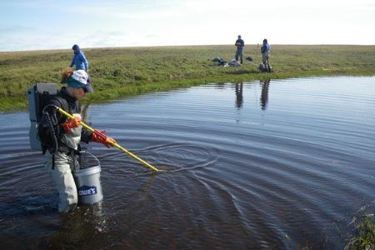Geospatial Patterns Of Antimicrobial Resistance Genes In The EPA National Rivers and Streams Assessment Survey
By U.S. EPA

The use of antibiotics and antimicrobials to treat infections has been revolutionary for human health and survival. However, bacteria have been able to evolve in response to their widespread use by developing antimicrobial resistance genes (ARGs). Having ARGs in their genomes can allow bacteria to escape the effects of certain classes of antibiotics, which is concerning because it can make certain infections difficult to treat.
Both antimicrobial products and antimicrobial-resistant bacteria find their way into the environment through the release of treated wastewater into rivers and streams, as well as through runoff from animal feeding operations. Bacteria have the unique ability to pass genes back and forth between one another, so it is possible that these genes could spread in the environment even in the absence of human hosts. EPA researchers are engaged in a variety of efforts to understand what happens when antimicrobial-resistant bacteria (sometimes referred to as antibiotic-resistant bacteria) are released into the environment.
EPA researchers examined some of these questions as part of the National Rivers and Streams Assessment Survey (NRSA), a large environmental sampling effort that takes place every 5 years. In 2013-14, survey crews collected water samples from over 1,800 sites covering rivers and streams across the entire lower 48 states and measured numerous indicators of water quality. The primary goal of the survey is to assess the quality of the nation’s rivers and streams using standardized field and lab methods for specific ecological indicators. The findings from NRSA will help researchers develop national standards for assessing the effects of human-associated contaminants, which include antibiotic resistant bacteria, on watershed ecosystems.
As part of this project, EPA researchers Nichole Brinkman and Scott Keely led a team who measured the abundance of different antimicrobial resistance genes in each of the samples. “NRSA was designed to study the impact of contaminants on ecosystems,” said Brinkman,” so we want to understand the contamination level of ARGs in rivers and streams.”
The study involved a tremendous effort among EPA researchers, state and tribal partners, and additional collaborators. “Processing over 2000 samples was no easy feat,” said EPA’s Emily Wheaton, who completed much of the sample processing for this part of the project. “Thankfully all water samples were filtered in the field and only the filters were shipped to our laboratories so that we could conduct DNA extractions for several months. But the fun didn’t stop there; this was followed by additional months running assays for the selected AMR gene targets.” These assays measured the abundances of different ARGs in all the samples, which researchers can then connect with other water quality data from the sampling locations.
The results provide a snapshot of the geospatial distribution of ARGs across the country’s waterways. “We want to know where the hotspots are,” said Keely, “and all of the genes tend to agree that the Eastern part of the country has more ARGs/antimicrobial resistance.” Conversely, the Western Mountains ecoregion was the least anthropogenically impacted, both in terms of ARGs and the other measures of water quality. The researchers were also able to find more specific associations between some of the ARGs measured and factors like watershed integrity, urbanity, water quality, and site disturbance. The gene intI1 in particular seemed to be highly associated with anthropogenic stressors and could potentially be a good indicator of broader ARG contamination.
Aside from being able to glimpse the bigger picture of ARG distribution across the country, the results from this study are important because they help us understand human exposure to ARGs. Brinkman says, “ARGs being in recreational waters and in sources of drinking water could be exposures that increase our risk; we could be exposed to these and develop resistance to antibiotics. But we don’t know that for sure yet.”
To address this, some of the group’s future work involves relating these results to risk frameworks. The NRSA sampling effort was also conducted in 2018-19 and 2023-24, so studying ARG distributions from these two additional surveys will provide a look at what is happening over time.
Read more:
